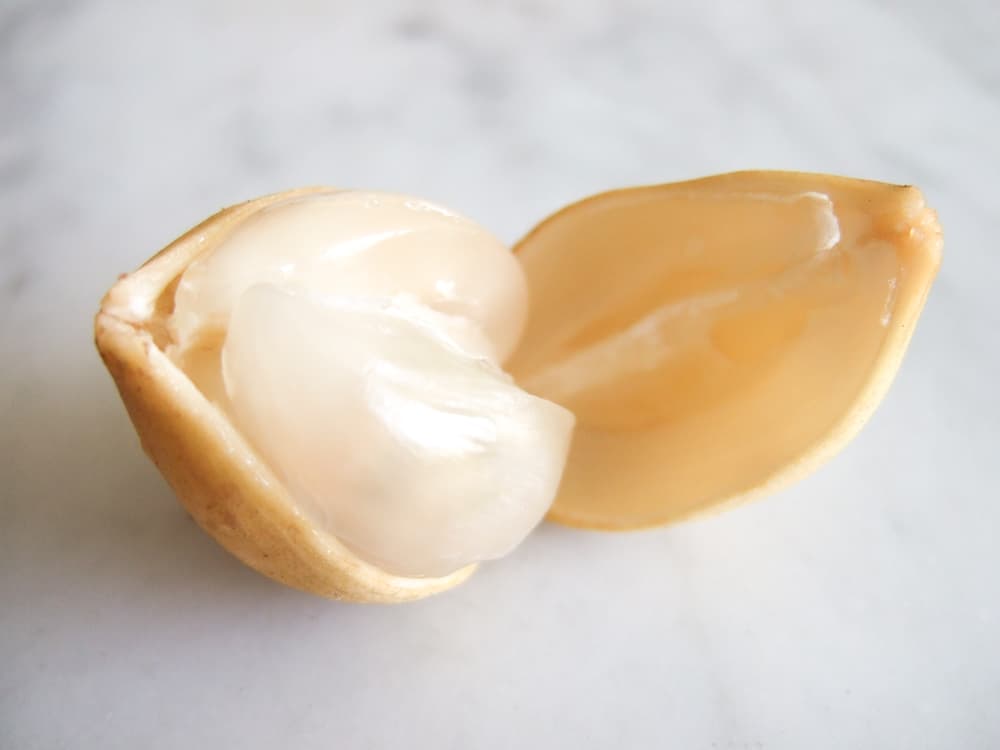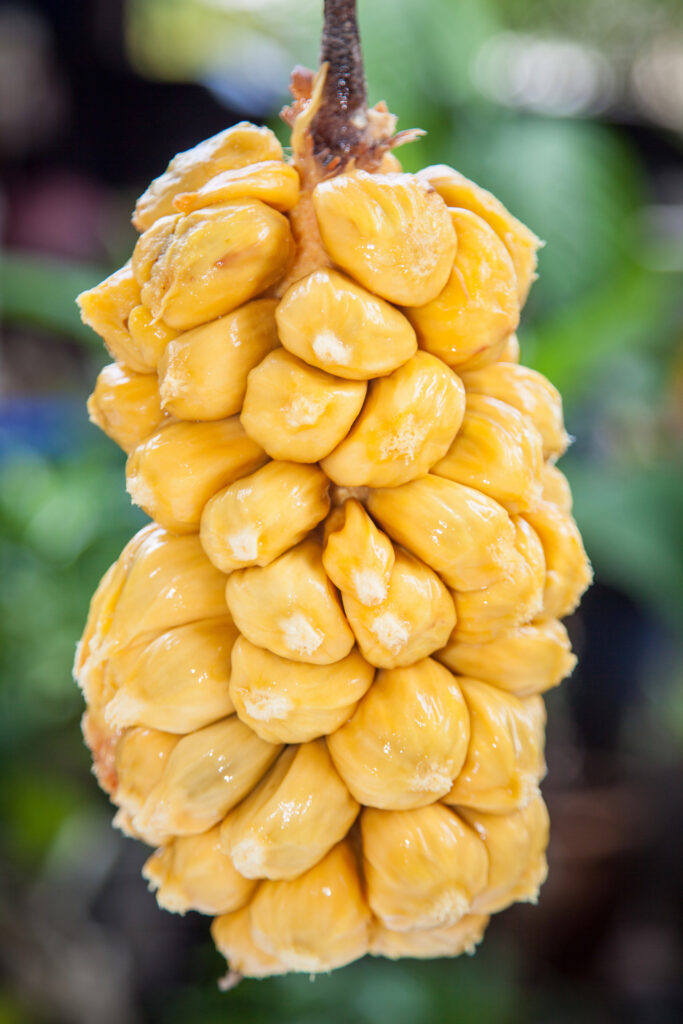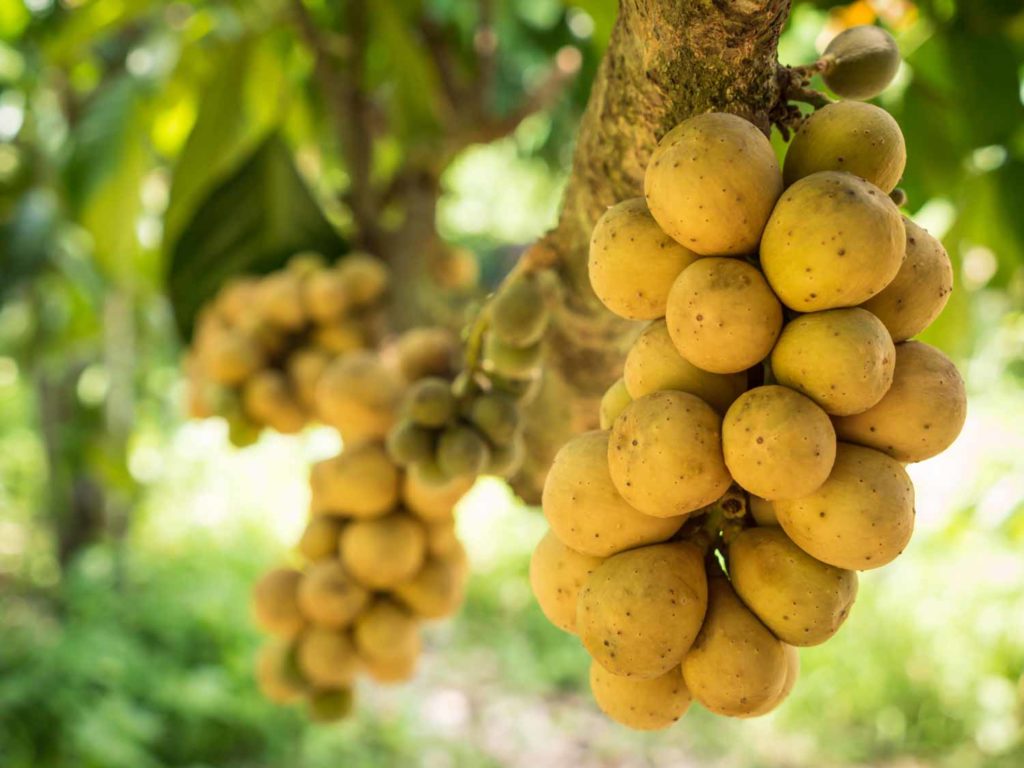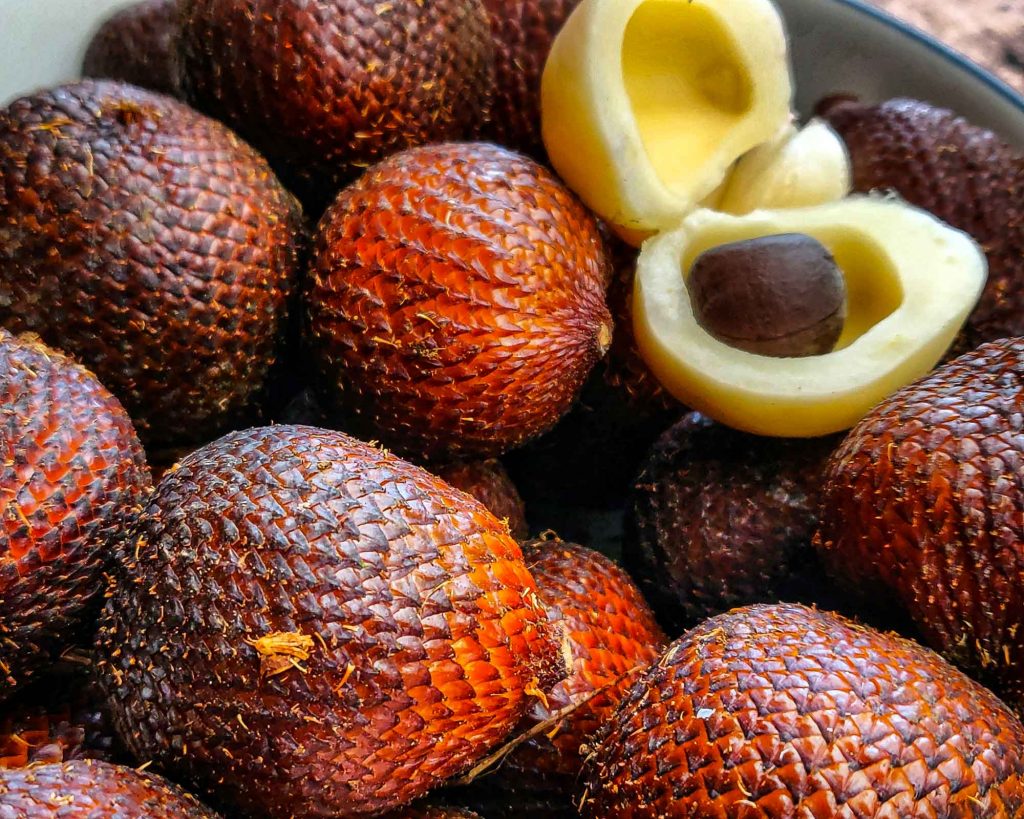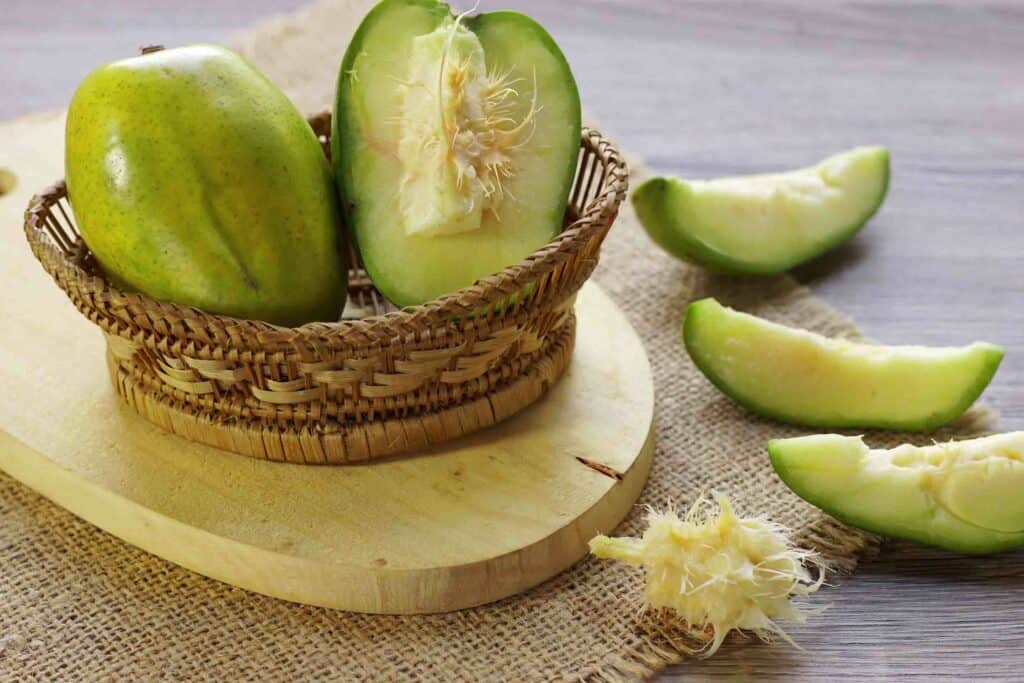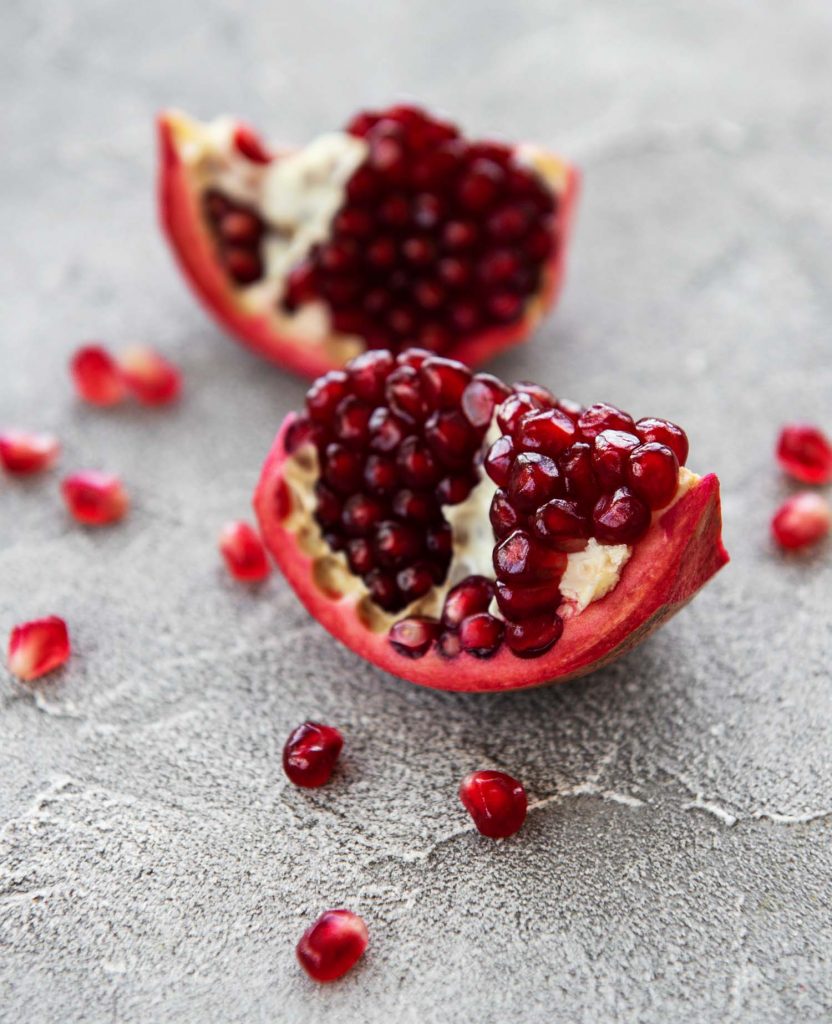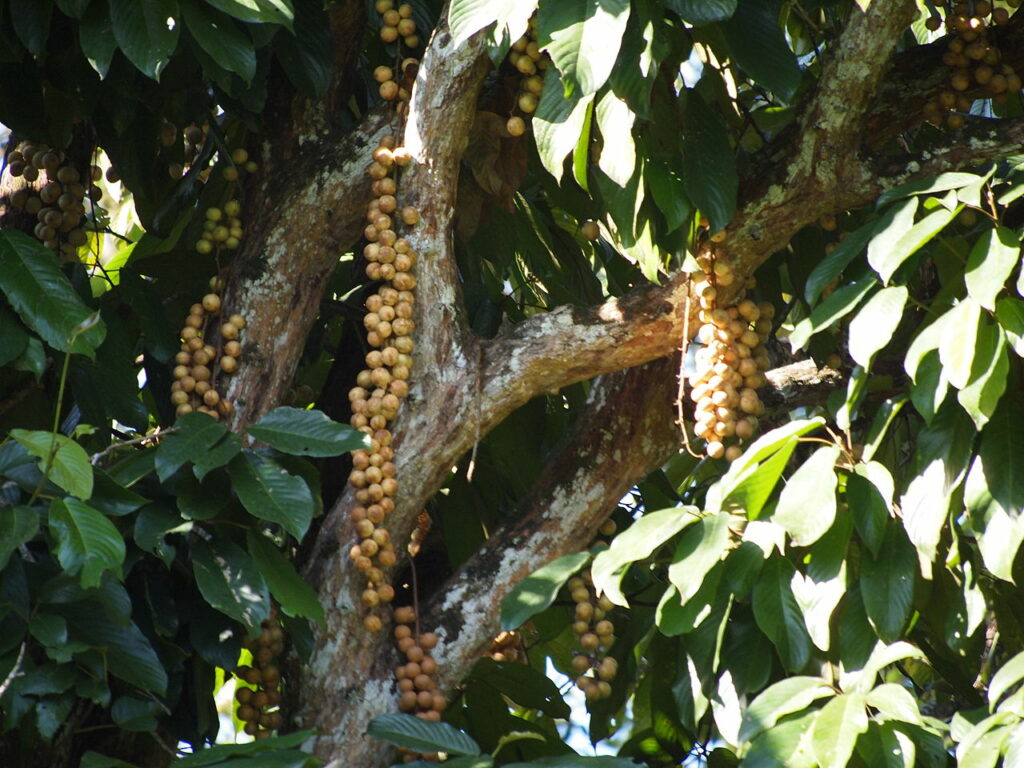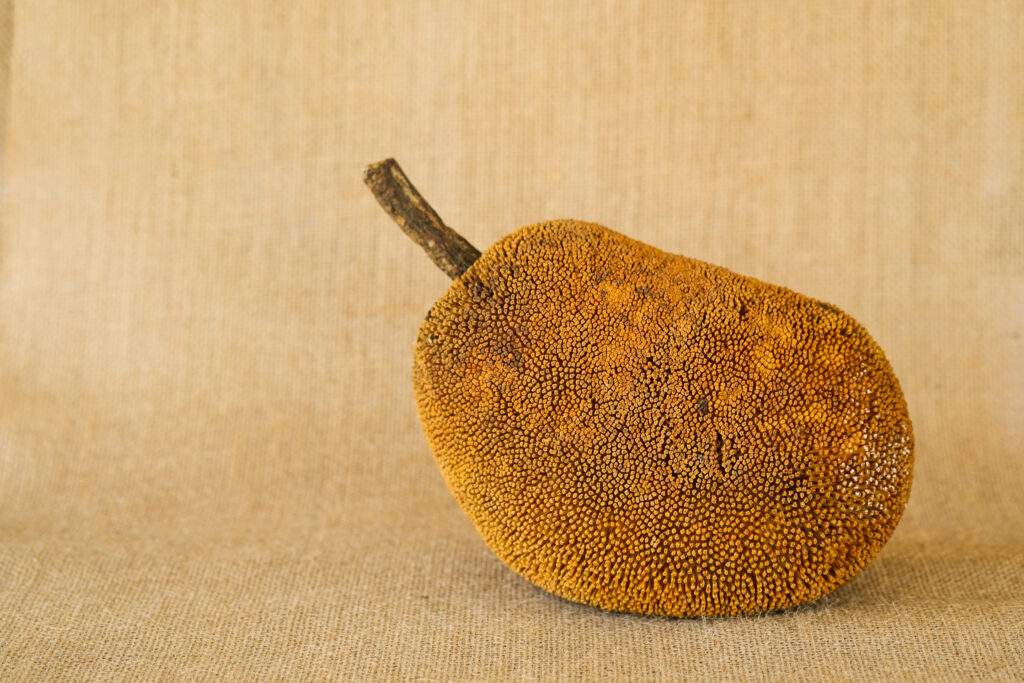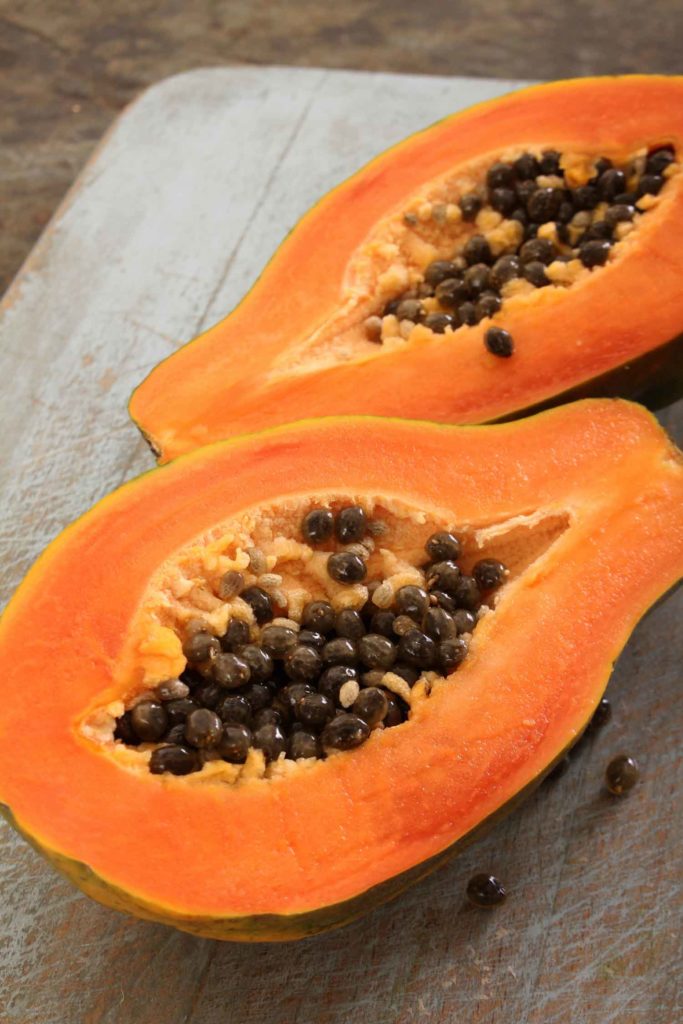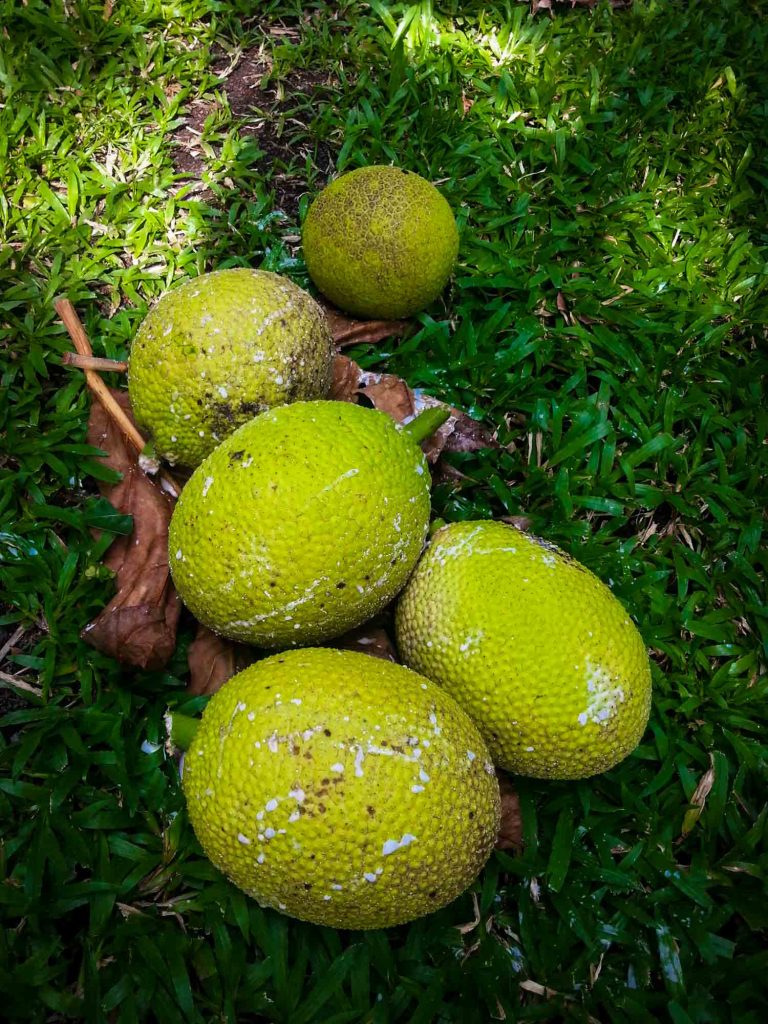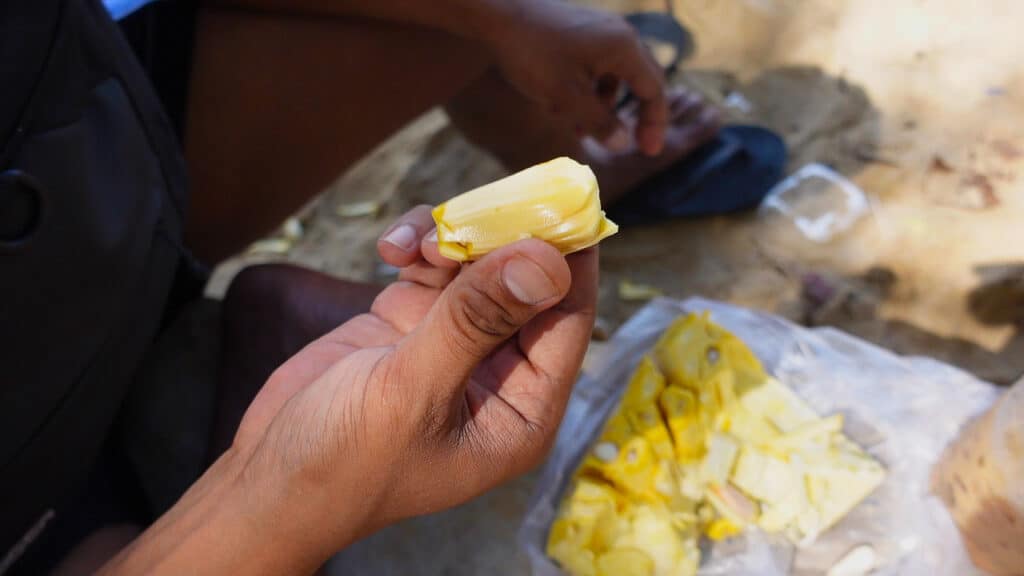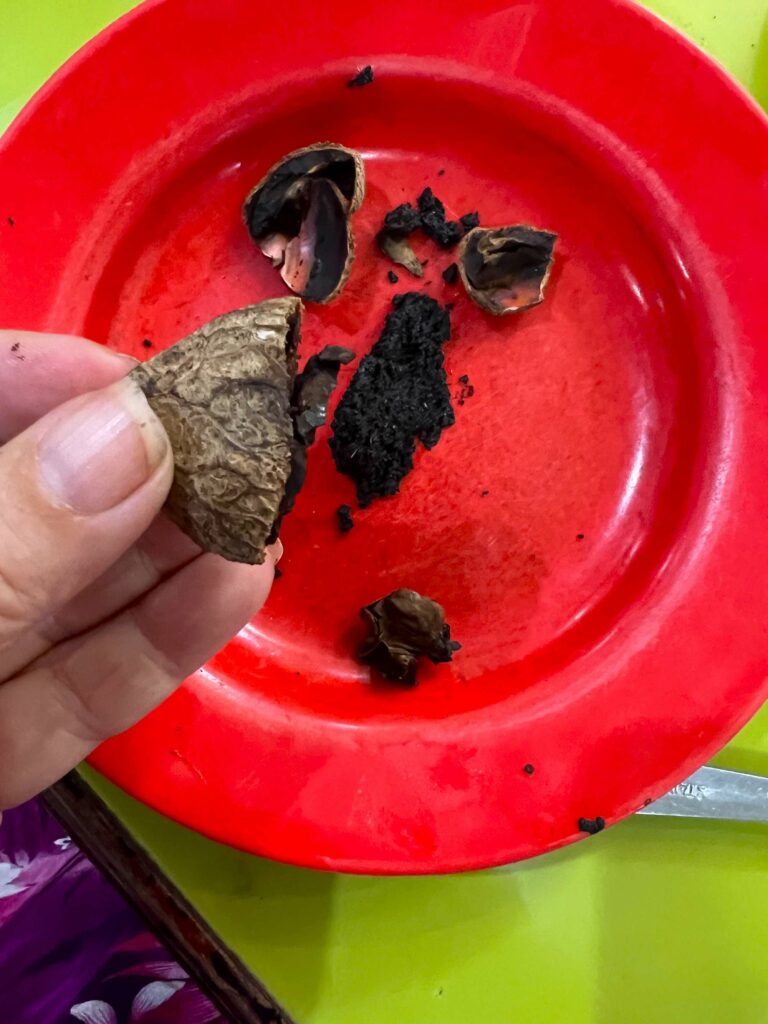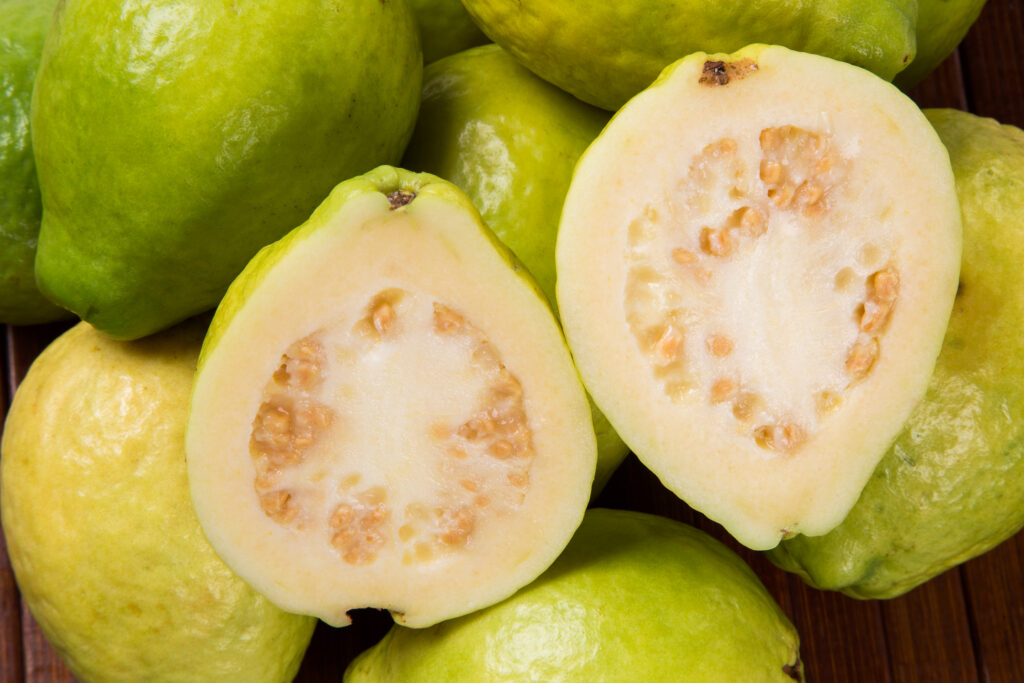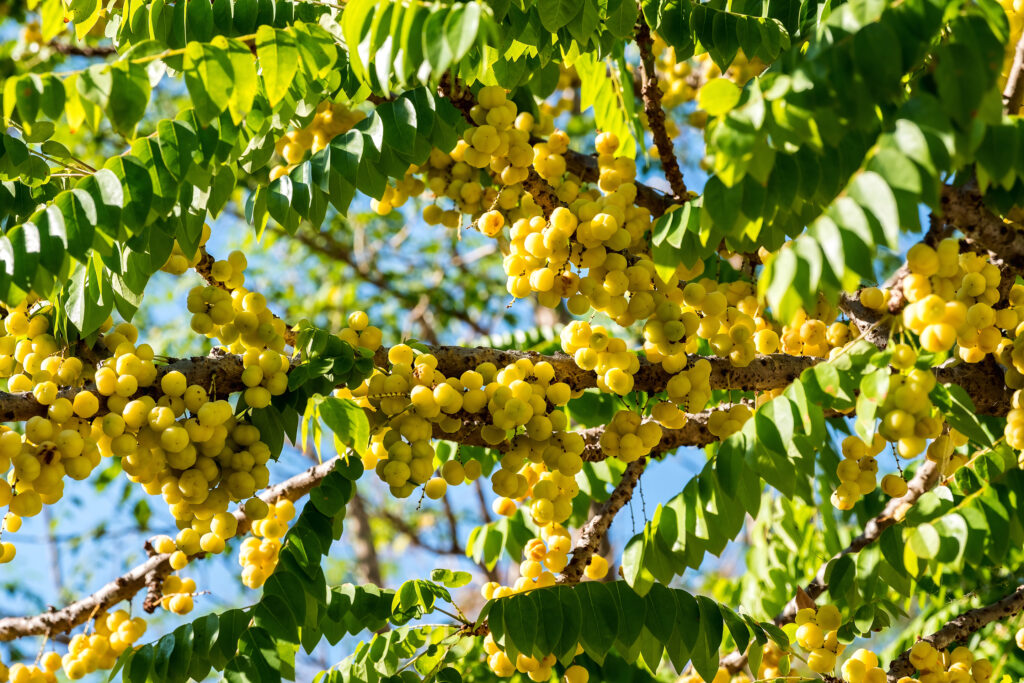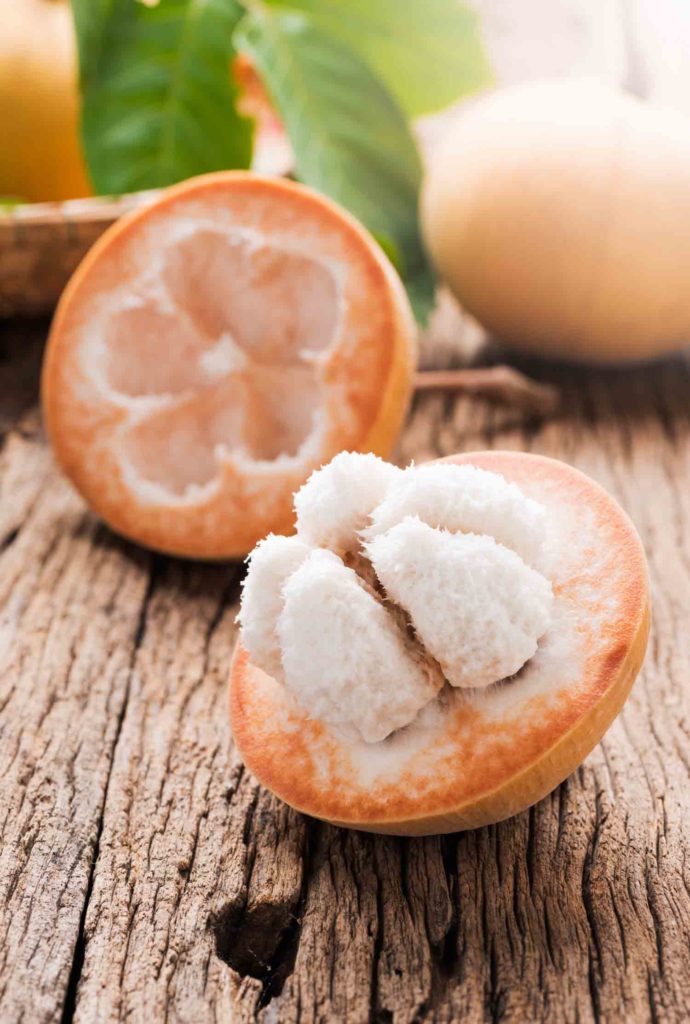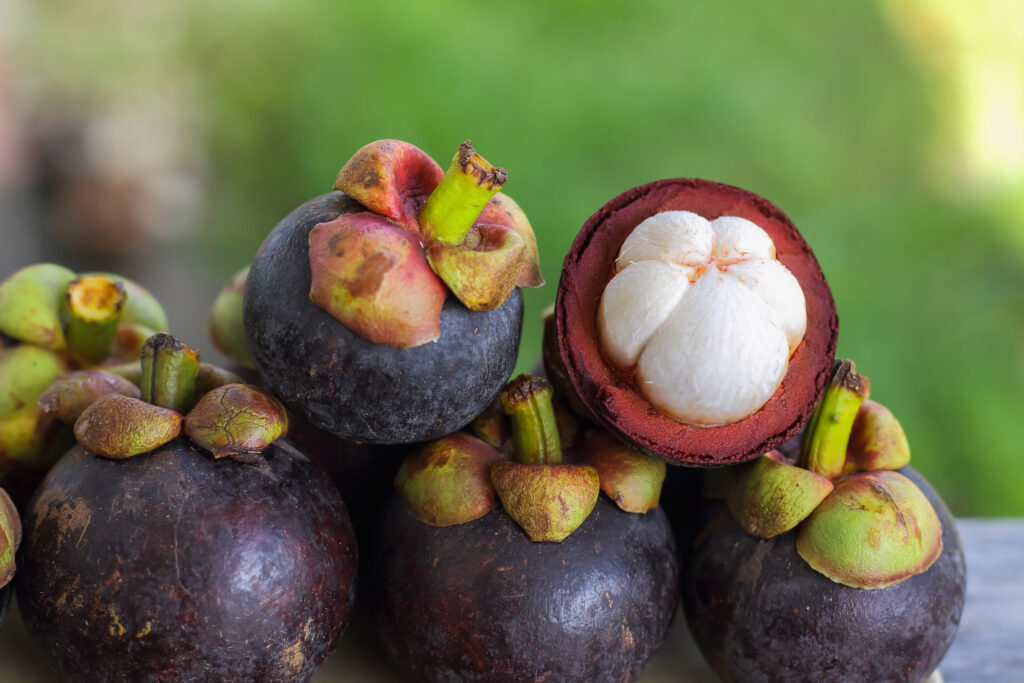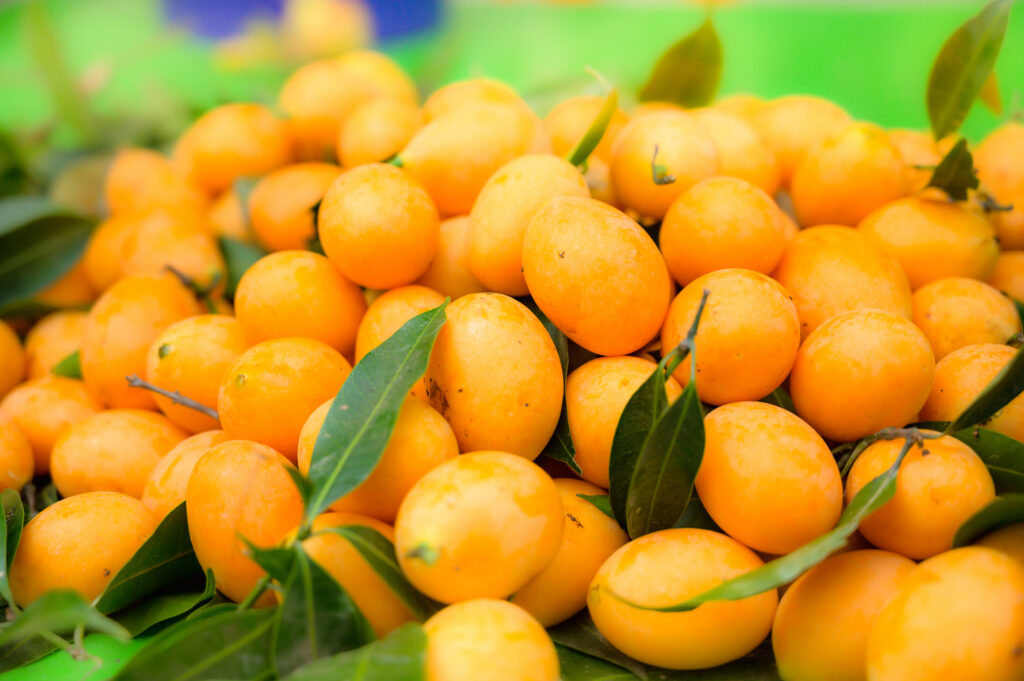Although many Malaysian fruit are exported, there’s nothing like eating it in this beautiful South East Asian country.
There are so many things to love about Malaysia.
I always carry a “must-eat fruit” list with me in every country I visit. But I was shocked at how many fruits in Malaysia I had never tried or even heard about.
What’s interesting about Malaysia is that it is basically a country split into two: Peninsular Malaysia and East Malaysia.
They are separated by 400 miles of the South China Sea but even that short distance can make such a difference what type of food is produced.
So far I have only visited Peninsular Malaysia but the exotic East Malaysia is on my list. It’s a bit more difficult to reach but I think it will be worth it.
Some of these fruits I ate in Malaysia and other more rare fruits are still on my wish list. But I am determined to find them!
MALAYSIAN FRUIT YOU’LL LOVE
1. Ciku | Sapodilla
Ciku is a round, brown Malaysian fruit with a leathery exterior and a sweet, creamy interior filled with black seeds.
Like many South East Asian fruit, you’ll also find them in Latin America. Ciku is very common in the Caribbean, Mexico and Central America.
It is one of my favourites because it doesn’t taste like a typical fruit.
I first discovered this fruit in Mexico as chico zapote and was shocked it had a malt flavour or brown sugar.
Scientific Name: Manilkara zapota
Other Common Names: chicozapote, chicoo, chicle, naseberry,, nispero, sapote, soapapple
Nutritional Benefits: Ciku is high in vitamin C, potassium, and fiber.
Cikul Season in Malaysia: October to December
2. Dukong | Langsat
Langsat is a small, round fruit with a thin, yellow or brown skin and a sweet, juicy interior filled with small seeds.
Yet langsat is different from duku and longkong although they look similar.
Langsat has a thin skin. Duku has a thicker skin and have different kinds of sap and levels of stickiness.
It tastes like a tart grape, almost as if a bit of pomelo or grapefruit was added.
You really have to know your fruits in Malaysia well to be able to tell the difference. I don’t but I love all of these fruits so it’s ok!
It’s also one of the most popular fruits in Bali.
Scientific Name: Lansium parasiticum
Other Common Names: lanzones or longkong
Nutritional Benefits: Langsat is high in vitamin C, potassium, and fiber.
Langsat Season in Malaysia: May to August
3. Cempedak | Chempedak
Cempedak is a large, green or yellow Malaysian fruit with a spiky exterior and a sweet, fleshy interior filled with large seeds.
It is in the same family as breadfruit and jackfruit. And it’s also large so in the markets they usually break it down into smaller pieces.
The flavor is unique. It tastes like a mango but with some funkiness of durian.
It’s also a very popular Cambodian fruit and fruit in Laos.
Scientific Name: Artocarpus integer
Other Common Names: Bangkong, Champedah, Chempedak, Chempedak Utan
Nutritional Benefits: May to August
Cempedak Season in Malaysia: Cempedak is high in vitamin C, potassium, and fiber.
4. Duku
Duku is a small, round fruit with a thin, yellow or brown skin and a sweet, juicy interior filled with small seeds.
It can be confusing because duku is also sometimes translated to langsat in English. The scientific names for duku and dukong show they are from the same family but different.
This is why these fruits in Malaysia are called two different things in Malay: duku and dukong with duku being the sweeter of the two
Scientific Name: Lansium domesticum
Other Common Names: Langsat, Langsat Hutan
Nutritional Benefits: Duku is high in vitamin C, potassium, and fiber.
Duku Season in Malaysia: May to August
5. Nangka Madu | Honey Jackfruit
Nangka madu is a small-ish, yellow or orange fruit with a sweet, juicy interior and a large seed.
From the jackfruit family it is very popular in places like Australia as it’s a smaller fruit than traditional jackfruit and very sweet.
The fruit is usually eaten by cutting it open and removing the flesh from around the seed.
The flesh can be eaten raw or used in desserts such as ice cream or cakes.
Nangka madu is a good source of energy and helps to improve digestion and boost the immune system.
It is also rich in antioxidants and can help to lower blood pressure and reduce the risk of heart disease.
Scientific Name: Artocarpus heterophyllus
Other Common Names: Jack, Jak, Jake Tree
Nutritional Benefits: Nangka madu is high in vitamin C, potassium, and fiber.
Nangka Madu Season in Malaysia: March to June
6. Salak / Snake Fruit
Salak is a small, brown Malaysian fruit with a scaly exterior and a sweet, crunchy interior filled with black seeds.
It is most often eaten raw. The skin is scaly and thin, almost like fish skin but easy to peel off and worth it. Salak tastes like a fruit cocktail of banana, apple and strawberry.
It is from Indonesia but has traveled far and wide.
I first discovered salak as an Ecuadorian fruit in the Amazon where they boil unripe fruit to eat.
Scientific Name: Salacca zalacca
Other Common Names: Salak palm, snake-fruited palm, snake-skinned fruit, Bali salak palm
Nutritional Benefits: Salak is high in vitamin C, potassium, and fiber.
Salak Season in Malaysia: May to August
7. Kedondong
Kedondong is a small, yellow or green fruit about the size of a pear but they taste like mango and pineapple.
Also known as ambarella, these fruits in Malaysia originated in Polynesia but were brought to Asia.
In the late 1700s they were brought to Jamaica, not only becoming one of the most popular Jamaican fruits but also spread throughout the Caribbean and Latin America.
Scientific Name: Spondias dulcis
Other Common Names: Ambarella, Golden Apple, Great Hog Plum, Otaheite Apple, Jew Plum, Yellow Plum
Nutritional Benefits: Buah kedondong is high in vitamin C, potassium, and fiber.
Buah Kedondong Season in Malaysia: May to August
8. Buah Delima | Pomegranate
Buah delima is a round, red Malaysian fruit with a tough, leathery exterior and a juicy, tart interior filled with seeds.
Pomegranate is originally from the region that is now Iran, south-west Pakistan and part of Afghanistan.
Today it’s found throughout the world and known as granada fruit in Chile.
In Iranian Christianity, pomegranate is also believed to be the real forbidden fruit. It’s common in Rosh Hashana food and you’ll find it in Holi food in India.
You don’t eat the fruit in Malaysia but instead the seeds.
Buah delima is a good source of antioxidants and can help to reduce inflammation and lower cholesterol levels.
It is also believed to have anti-cancer properties and can improve digestion.
Scientific Name: Punica granatum
Other Common Names: Anar, Ganada, Granatapfel, Grenade, Melograno, Nar, Romã
Nutritional Benefits: Buah delima is high in vitamin C, potassium, and fiber.
Buah Delima Season in Malaysia: August to November
9. Rambai
Rambai is a small, round fruit with a green or yellow skin and a sweet, juicy interior filled with small seeds.
This Malaysian is a native fruit in Indonesia, Thailand and Peninsular Malaysia. It now also grow in northern Australia and China.
Scientific Name: Baccaurea motleyana
Other Common Names: Asam Lambun, Mafai-farang (Thailand), rambi,
Nutritional Benefits: Buah rambai is high in vitamin C, potassium, and fiber.
Buah Rambai Season in Malaysia: It is eaten fresh and is in season from June to August.
10. Jentik-Jentik | Lempoang
Jentik-jentik is a small, red or yellow fruit with a sweet, juicy interior and a large seed.
It is eaten fresh.
This Peninsular Malaysia fruit also grows in Indonesia, Philippines and Thailand. It thrives in lowland rainforest areas but is eaten more as a wild fruit as it’s quite sour. It often needs sugar or salt.
Scientific Name: Baccaurea lanceolata
Other Common Names:
Nutritional Benefits: Jentik-jentik is high in vitamin C, potassium, and fiber.
Jentik-Jentik Season in Malaysia: June to August
11. Tarap
Tarap is a large, green or brown Malaysian fruit with a spiky exterior and a sweet, fleshy interior filled with large seeds.
It is native to eastern Malaysia, Borneo, Brunei and Kalimantan in Indonesia. It’s a close cousin to jackfruit.
The scientific name uses odoratissimus and that’s because it is a stinky Malaysia fruit.
It’s not as bad as durian but it smells like propane or diesel when ripe. I haven’t tried it yet but they say it’s better than jackfruit and tastes a bit like creamy banana.
Scientific Name: Artocarpus odoratissimus
Other Common Names: marang, madang, timadang, terap, tarap, kiran, green pedalai, or johey oak
Nutritional Benefits: Buah tarap is high in vitamin C, potassium, and fiber.
Tarap Season in Malaysia: May to August
12. Terung Dayak | Hairy Fruited Eggplant
Terung dayak is a small, purple fruit with a tart, sour flavor. It is used in savory dishes and particularly soup.
It also grows in Thailand, Indonesia and is a common Filipino fruit.
Scientific Name: Solanum ferox
Other Common Names: Indian nightshade
Nutritional Benefits: Terung dayak is high in vitamin C, antioxidants, and fiber.
Terung Dayak Season in Malaysia: May to August
13. Betik / Papaya
Papaya is the national fruit of Malaysia. I think this shocks many Malaysians as there are so many other unique fruits but it’s fruit.
Papaya is a tropical fruit with a soft, sweet flesh and a slightly musky flavor. It is usually eaten when ripe and has a bright orange color and a soft texture.
I really struggle with the texture of papaya. Sometimes it is too mushy and has a stinky feet flavour. But I actually like this fruit in Malaysia.
It’s probably because papaya is used so many ways here, including salads, curries, and desserts.
Fun fact: throughout Latin America this Malaysia fruit is known as papaya. Except one country! The Cuban fruit is known as fruta bomba because papaya is a slang term for female genital’s in Cuba
Papaya has anti-inflammatory properties and may help to reduce the risk of heart disease. Locals believe it helps with certain types of cancer.
Also, it is low in calories and may help to promote healthy skin and hair.
Scientific Name: Carica papaya
Other Common Names: Betek, Fruta Bomba, Pawpaw, Melon Tree, Ketalah
Nutritional Benefits: Papaya is high in vitamin C, vitamin A, and potassium. It is also a good source of fiber and contains an enzyme called papain, which can aid in digestion.
Betik Season in Malaysia: All year round
14. Sukun | Breadfruit
Sukun is a large, green or yellow fruit with a spiky exterior and a starchy, potato-like interior. It is used in savory dishes.
I first discovered when I visited the Breadfruit Institute in Maui. There are so many delicious fruit in Hawaii but this one is special.
In Hawaii sukun is known as ulu and they believe that it can help with hunger around the world.
There are over 150 varieties around the world. It can basically replace any kind of starch and has more nutrients.
When cooked it tastes like bread. But I’ve also had it over ripe where it is like a creamy pudding.
Scientific Name: Artocarpus altilis
Other Common Names: Kulur, Kelor, Suku, Ulu
Nutritional Benefits: Buah sukun is high in carbohydrates, fiber, and potassium.
Sukun Season in Malaysia: May to August
15. Buah Pala | Jackfruit
Buah pala is a large, green or yellow fruit with a spiky exterior and a sweet, fleshy interior filled with large seeds.
Originally from India’s Western Ghats jackfruit is the largest edible fruit in the world.
Don’t worry you don’t have to buy an entire jackfruit. In markets they break it up into smaller pieces.
You can find jackfruit in savory curries and it is delicious raw. I first tried this fruit in Vietnam when my guesthouse host broke off a large piece.
And I was hooked. It tastes like mango, pineapple and banana mixed together.
Scientific Name: Artocarpus heterophyllus
Other Common Names: Jack, Jak, Jake Tree, Yaca
Nutritional Benefits: Buah pala is high in vitamin C, potassium, and fiber.
Buah Pala Season in Malaysia: May to August
16. Buah Merah | Red Fruit
Buah merah is a rare red fruit with a tart, sour flavor. It is used in savory dishes.
Also found in Papua New Guinea and Papua Indonesia these fruits in Malaysia are typically prepared by splitting it, wrapping it in leaves, and cooking it in an earth oven.
It’s similar to a screwpine fruit, and looks like a long cylinder-like jackfruit, except it’s red.
Although it hasn’t been scientifically proven yet but buah merah appears to help with lung cancer and inhibiting some tumors.
Scientific Name: Pandanus conoideus
Other Common Names: Kuansu, Buah Merah, Screwpine, Marita, Oil Pandan and Red Pandanus
Nutritional Benefits: Buah merah is high in Omega 3,6 and 9 essentially fatty acids.
Buah Merah in Malaysia: May to August
17. Keluak
Keluak is a small, black Malaysian fruit with a hard shell and a bitter, nutty flavor. It is a key ingredient in royal dishes as well as in Peranakan cuisine of southern Chinese immigrants.
The first time I had keluak was exploring Surabaya food in Indonesia, where it was also an ingredient in royal dishes and still used today.
I learned it is poisonous if eaten raw as it contains cyanide.
But keluak has been cured for centuries to make it edible. This fruit in Malaysia must be first boiled and then buried in ash in the ground to ferment.
Scientific Name: Pangium edule
Other Common Names: Kepayang, Pangi, Payang
Nutritional Benefits: Buah keluak is high in protein, iron, and fiber.
Keluak Season in Malaysia: June to August
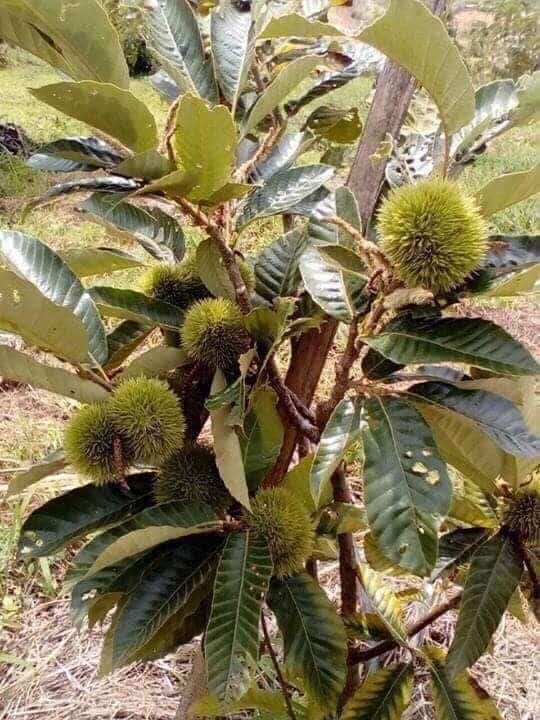
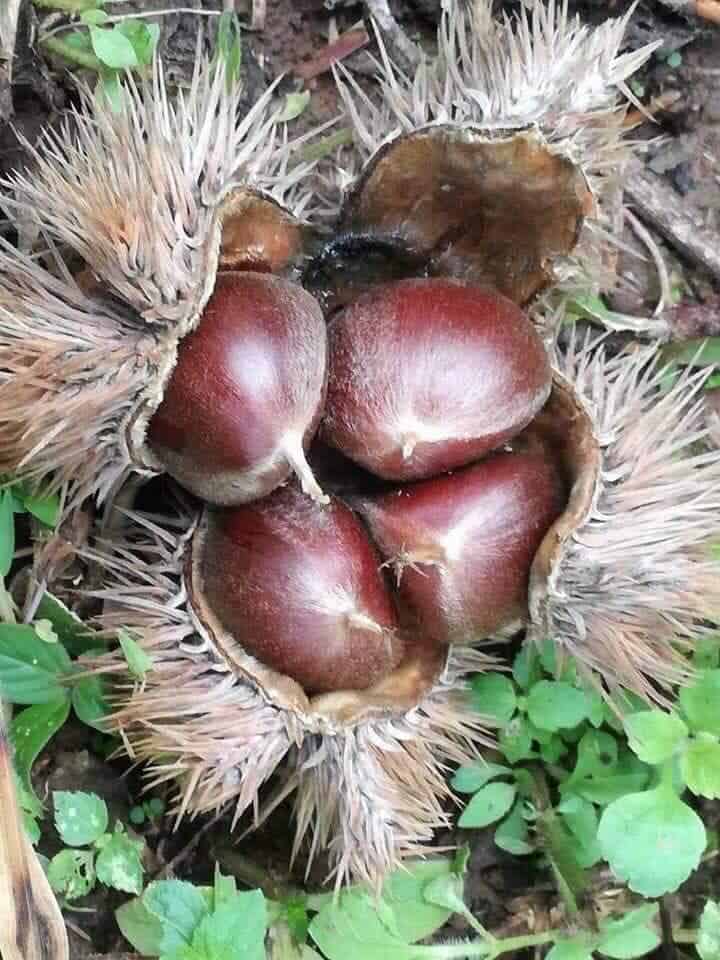
18. Buah Berangan | Chestnuts
Buah berangan is a large, green or brown fruit with a spiky exterior and a sweet, fleshy interior filled with large seeds.
These Malaysian fruits originated in the area of northern Borneo, Philippines, Sulawesi and Malaku in Indonesia.
Buah berangan looks like a cross between a western chestnut and jengkol in Indonesia.
It is eaten fresh or used in desserts.
Scientific Name: Artocarpus sericicarpus
Other Common Names: GumihBulu
Nutritional Benefits: Buah berangan is high in vitamin C, potassium, and fiber.
Buah Berangan Season in Malaysia: June to August
19. Jambu Batu | Guava
Jambu batu is a round, crunchy fruit with a white or pink interior and a thin, edible skin.
They are often mistakenly referred to as Brazilian fruits because of the common name Brazilian white guava.
But guava is originally from southern Mexico and Central America where the pink interior is more common but white and yellow also exist.
Jambu batu is sweet like a strawberry with just a touch of sour. It’s very refreshing.
Jambu batu is low in calories and high in antioxidants, which can help to protect the body against free radical damage.
It is also a good source of water and can help to keep the body hydrated.
Scientific Name: Psidium guajava
Other Common Names: Apple Guava, Jambu Biji, Jambu Kampuchia, Yellow Guava
Nutritional Benefits: Jambu batu is high in vitamin C, potassium, and fiber.
Jambu Batu Season in Malaysia: March to June.
20. Cermai | Malay Gooseberry
Cermai is a small, green fruit with a tart, sour flavor. It is eaten fresh or used in cooking with a lot of sugar.
It looks and tastes a bit like nance fruit in Guatemala but they are not related.
No one knows with certainty where it originated but many believe this Malaysia fruit is from Madagascar.
Cermai is believed to have anti-inflammatory properties and may help to reduce the risk of certain types of cancer.
It is also low in calories and may help to promote healthy digestion.
Scientific Name: Phyllanthus acidus
Other Common Names: Arbari, Country gooseberry, Malay gooseberry, Otaheite gooseberry, Star gooseberry, starberry, Tahitian gooseberry, West India gooseberry
Nutritional Benefits: Cermai is high in vitamin C, potassium, and fiber.
Cermai Season in Malaysia: May to August
21. Buah Sentul
Buah sentul is a small, round fruit with a tough, brown exterior and a sweet, juicy interior filled with seeds.
It’s known as cotton fruit because of its texture and has a flavour of apple and peach.
It’s originally from South East Asia, a treasured Thai fruit, but not always easy to find as the Philippines.
Scientific Name: Sandoricum koetjape
Other Common Names: Cotton fruit, Kechapi, Kecapi, Kelampu, Ketjape, Ketuat, Lolly Fruit, Red Santol, Ranggu, Santol, Sentol, Yellow Sentol,
Nutritional Benefits: Buah sentul is high in vitamin C, potassium, and fiber.
Santul Season in Malaysia: June to August
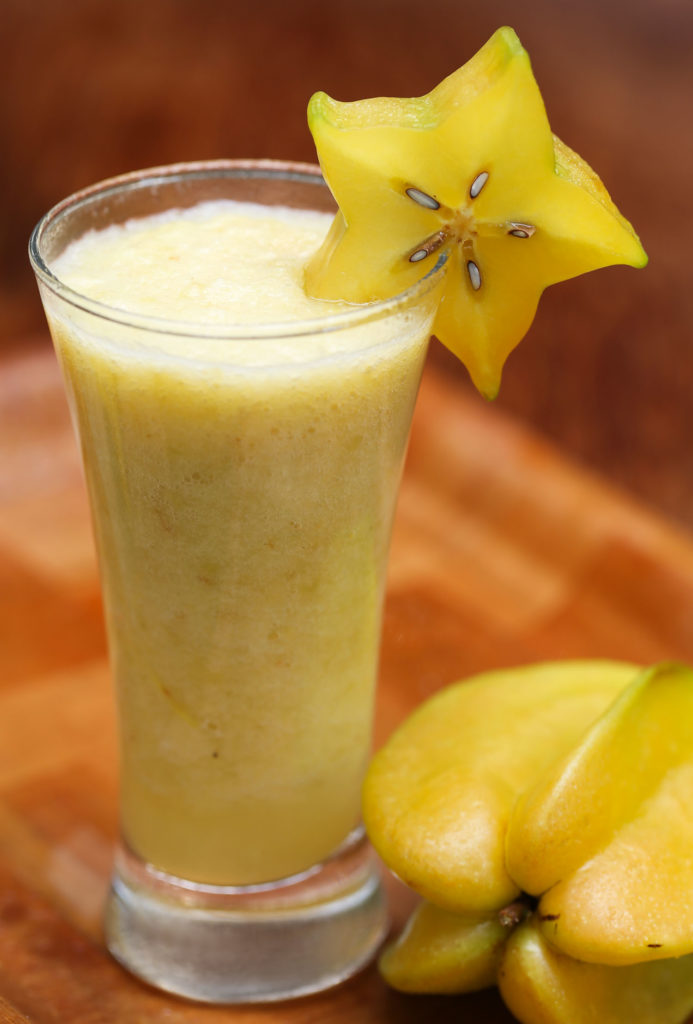
22. Belimbing | Starfruit
Belimbing is a yellow or green fruit with a star-shaped cross-section and a sweet, tangy flavor.
Although you can find it throughout the Americas it originated in Malaysia, Indonesia and Southern China.
It’s also a common Costa Rica fruit and found throughout Latin America.
It can be eaten freshly sliced and has a citrusy sour flavor. In many cases sugar is needed to combat the tartness.
Scientific Name: Averrhoa carambola
Other Common Names: Carambola, Caramba, Country Gooseberry, Kamrak, Kembola,
Nutritional Benefits: Belimbing is high in vitamin C, potassium, and fiber.
Belimbing Season in Malaysia: May to August
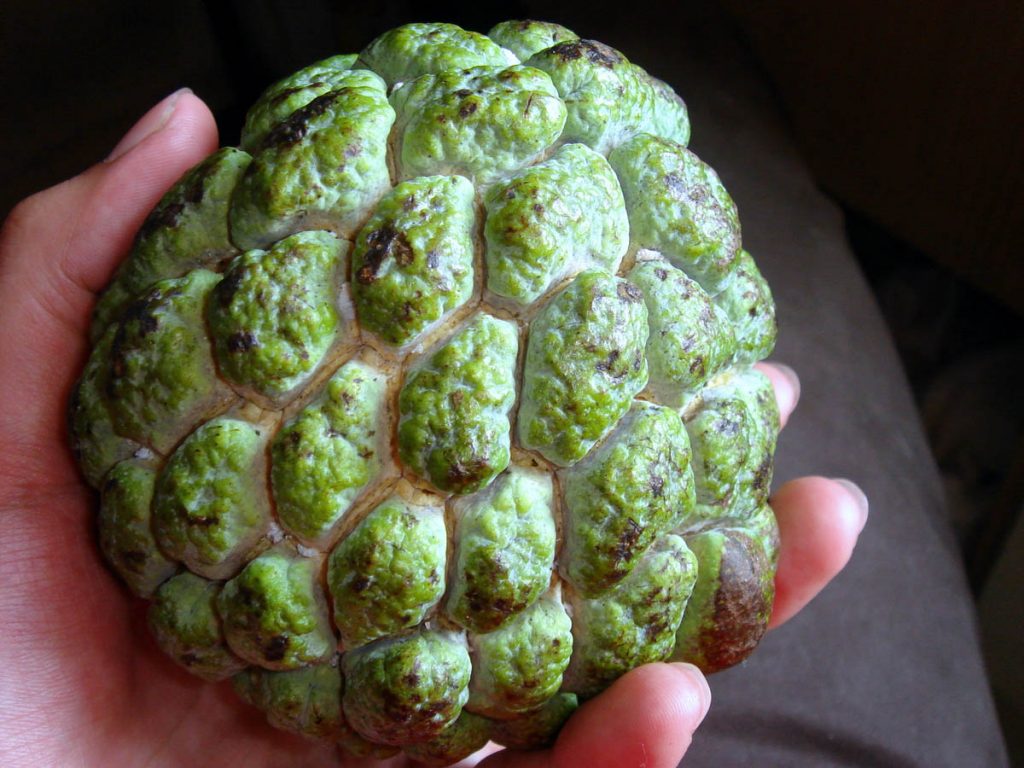
23. Buah Nona | Custard Apple
Buah nona is a large, green or yellow Malaysian fruit with a bumpy exterior and a sweet, creamy interior filled with black seeds.
It is eaten fresh or used in desserts and is fantastic in smoothies and ice cream.
Surprisingly nona is not native to South East Asia but originated in southern Central America and into South America.
It is related to soursop and cherimoya.
Scientific Name: Annona squamosa
Other Common Names: Anona, Bullock’s Heart, Custard Apple, Sugar Apple, Sirkaya, Seri Kaya, Sweetsop,
Nutritional Benefits: Buah nona is high in vitamin C, potassium, and fiber.
Buah Nona Season in Malaysia: June to August
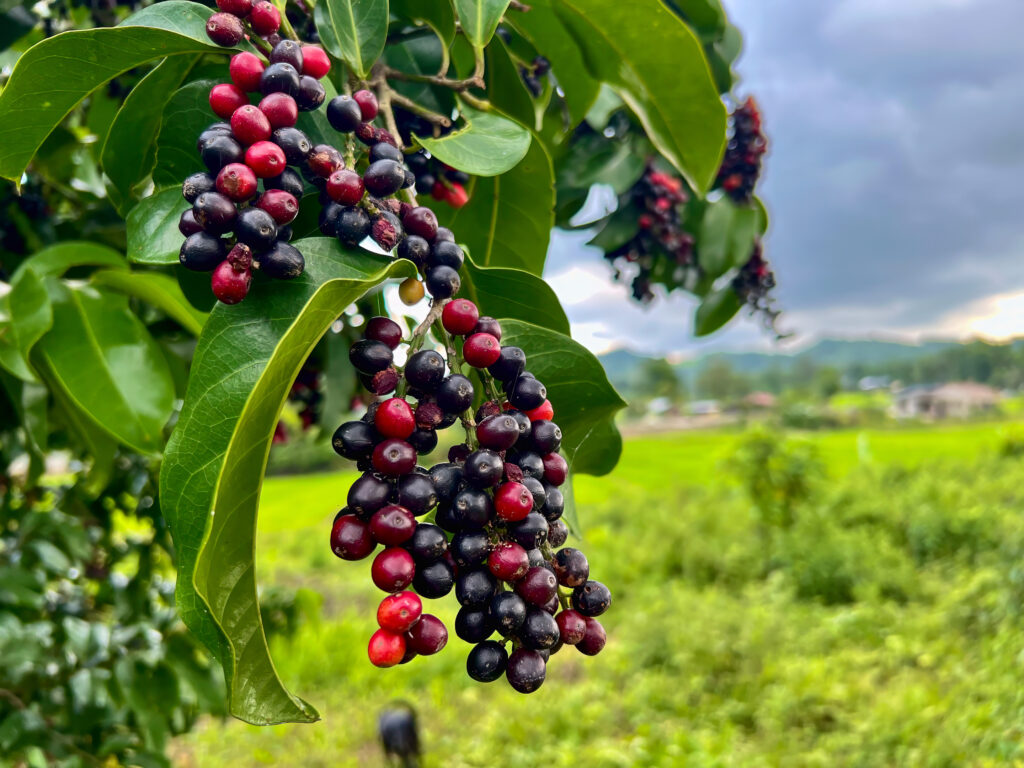
24. Mata Kucing
Mata kucing is a small, round fruit with a tough, brown exterior and a sweet, juicy interior filled with seeds.
It’s native to South East Asia but comes under many names. Unripe they taste tart like a cranberry and become sweet when mature.
Scientific Name: Antidesma bunius
Other Common Names: Berunai, Bignay, Buynay, Buni, Chinese Laurel, Currantwood
Nutritional Benefits: Mata kucing is high in vitamin C, potassium, and fiber.
Mata Kucing Season in Malaysia: June to August
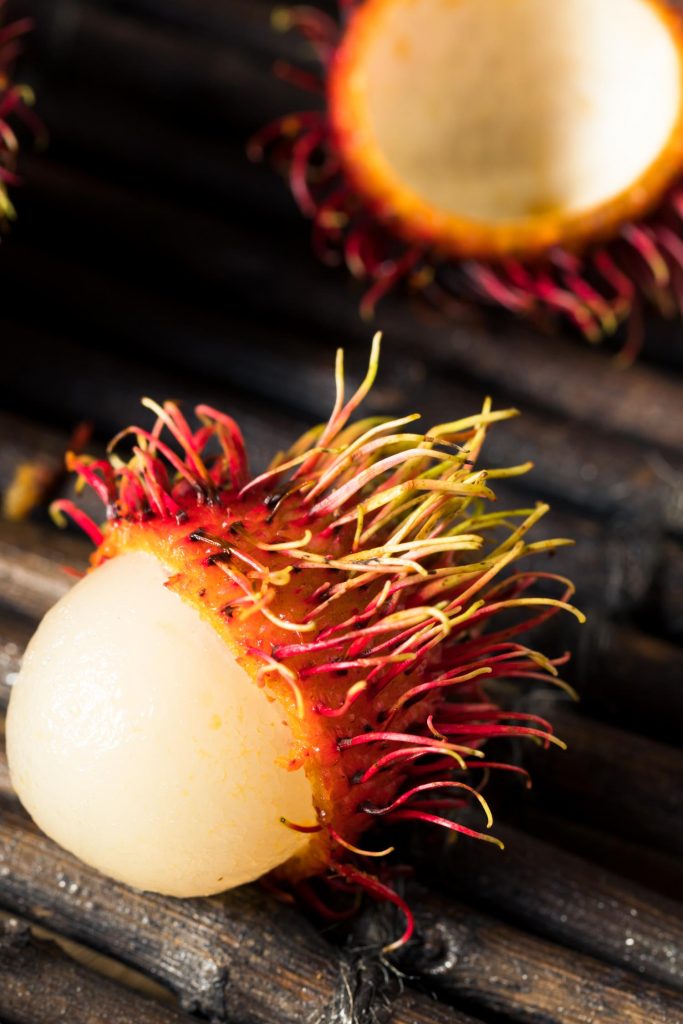
25. Rambutan
Rambutan is a small, red or yellow fruit with a hairy exterior and a sweet, juicy interior. It is eaten fresh or used in desserts.
It’s one of my favourite fruits as it balances sour and sweet perfectly. Rambutan tastes like a strawberry lychee cocktail.
When buying at the market it may be sold in a bunch on branches. As rambutan does not continue to ripen after picking look for a bunch of vibrant red fruit.
And don’t hesitate to tell vendors which ones you don’t want.
In several markets a seller thought she might be able to sell some of the unripe fruit to an unsuspecting tourist. But I politely pointed to the fruit I did not want.
If they are on branches look for the best bunch.
Rambutan is originally from Malaysia and Indonesia but now widely cultivated throughout Asia and throughout the Americas. For example it’s one of the most popular fruits in Panama.
Scientific Name: Nephelium lappaceum
Other Common Names:
Nutritional Benefits: Rambutan is high in vitamin C, iron, and fiber.
Rambutan Season in Malaysia: June to August
26. Durian
Durian is known as the king of fruits.
It’s a large, spiky fruit with a pungent odor and a creamy, custard-like flesh filled with large seeds.
This Malaysia fruit is so stinky there are signs posted that you cannot enter many buildings with it.
Durian is native to Borneo and Sumatra Indonesia. But today it’s found throughout South East Asia.
Malaysians take durian seriously. In the video above I visited a durian vendor who had ore than 20 kinds.
We purchased the cheapest fruit for $12 and it was delicious but more rare varieties cost up to 10 times more.
It’s hard to say what durian tastes like because there are so many varieties. I prefer the yellow fleshed durian which are more fruity with a hint of funkiness. The white flesh tend to be more creamy and funky.
So if you try durian once and don’t like it just keep trying when offered.
Scientific Name: Durio zibethinus
Nutritional Benefits: Durian is high in vitamin C, potassium, and fiber.
Durian Season in Malaysia: May to September
27. Manggis | Mangosteen
Mangosteen is originally from Malaysia.
This Malaysian fruit is round, purple fruit with a thick, leathery rind and a sweet, juicy interior filled with white segments.
Many tourists are intimidated by mangosteen because they don’t know how to eat it.
Simply put the fruit between your enlaced hands and push down to apply pressure and it will break into two.
Peel off the leathery skin and suck on the seeds.
Depending on the sweetness mangosteen tastes like lychee with strawberry and pineapple.
You can find manggis throughout South East Asia and in the Americas where it’s a very popular Colombian fruit.
Scientific Name: Garcinia mangostana
Other Common Names: Mangosteen, Mesetor, Sementah, Semetah
Nutritional Benefits: Mangosteen is high in antioxidants, fiber, and vitamin C.
Manggis Season in Malaysia: May to September
28. Nangka | Jackfruit
Jackfruit is a large, green or yellow fruit with a spiky exterior and a sweet, fleshy interior filled with large seeds.
Although it is well known as a vegan replacement for pulled pork in western cuisine, the Malaysian fruit is often eaten fresh and tastes like a fruit cocktail of strawberry, banana, pear.
It’s also used in many savory Malaysian dishes.
It’s another fruit that became very popular in the Americas and one of the most popular fruits in Nicaragua.
Scientific Name: Artocarpus heterophyllus
Other Common Names:
Nutritional Benefits: Jackfruit is high in vitamin C, potassium, and fiber.
Nangka Season in Malaysia: March to June
29. Nanas | Pineapple
Pineapple is a large, yellow fruit with a spiky exterior and a sweet, juicy interior.
It’s found throughout the world and is absolutely delicious in Malaysia as there are so many varieties.
Scientific Name: Comosus
Other Common Names: ananas, piña
Nutritional Benefits: Pineapple is high in vitamin C, manganese, and fiber.
Nanas Season in Malaysia: March to June
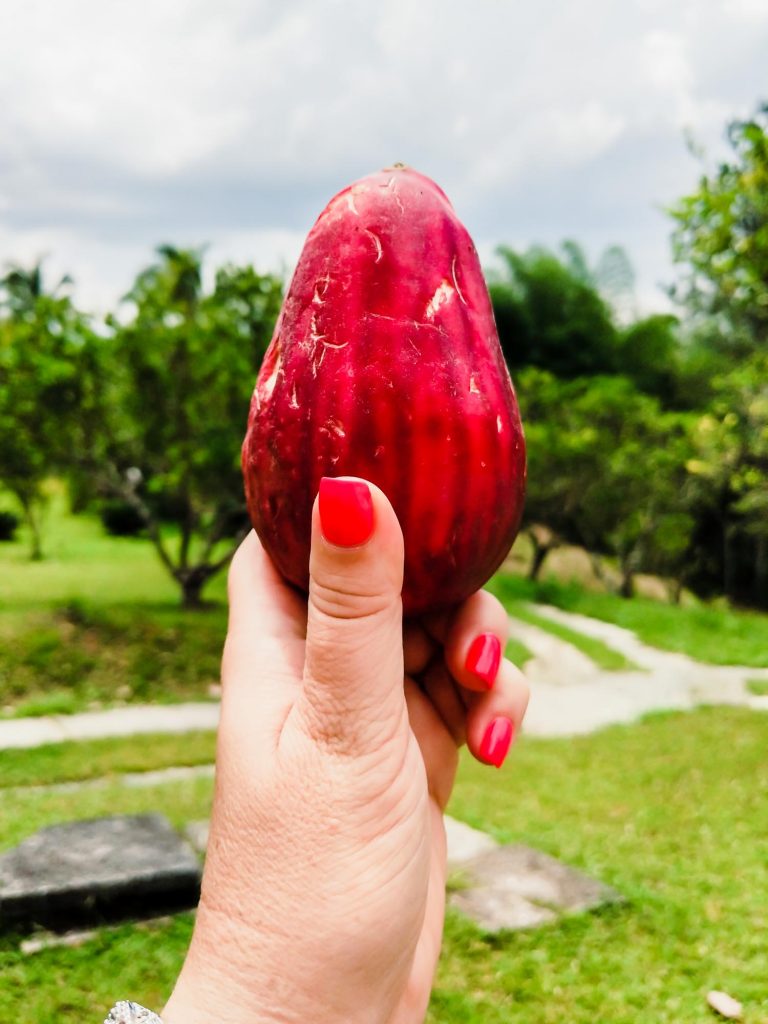
30. Jambu Air | Water Apple
Jambu air is a round, pink or green Malaysian fruit with a crunchy texture and a sweet, refreshing flavor. It is eaten fresh or used in salads.
It’s fresh like watermelon and pear. And there’s a reason why it’s called water apple or manzana de agua fruit in Costa Rica as it’s dense with watery juice.
You can find this Malaysia fruit around the world, it’s known as the pommerac fruit in Trinidad and mountain apple in Jamaica.
Scientific Name: Syzygium aqueum
Other Common Names: Bell Fruit, Jambu Air Mawar, Jambu Chili, Java Apple, Jambu Ayer, Water Apple, Water Cherry, Water Rose Apple, Watery Rose Apple
Nutritional Benefits: Jambu air is high in vitamin C, potassium, and fiber.
Jambu Air Season in Malaysia: May to August
31. Buah Kundang | Plum Mango
Buah kundang is a small, red or yellow Malaysian fruit with a sweet, juicy interior and a large seed.
It’s native to South East Asia and usually eaten fresh. The texture is like a plum but it tastes more like a mango.
It comes from the same family as cashew fruit.
Scientific Name: Bouea macrophylla
Other Common Names: Gandaria, Maprang, Mango Plum
Nutritional Benefits: Buah kundang is high in vitamin C, potassium, and fiber.
Buah Kudang Season in Malaysia: June to August
Malaysian Fruit Images: Rambai Tu7uh, CC BY-SA 3.0, via Wikimedia Commons, Terung Dayak Vinayaraj, CC BY-SA 4.0 https://creativecommons.org/licenses/by-sa/4.0, via Wikimedia Commons, Tarap (c)
CW Gan

